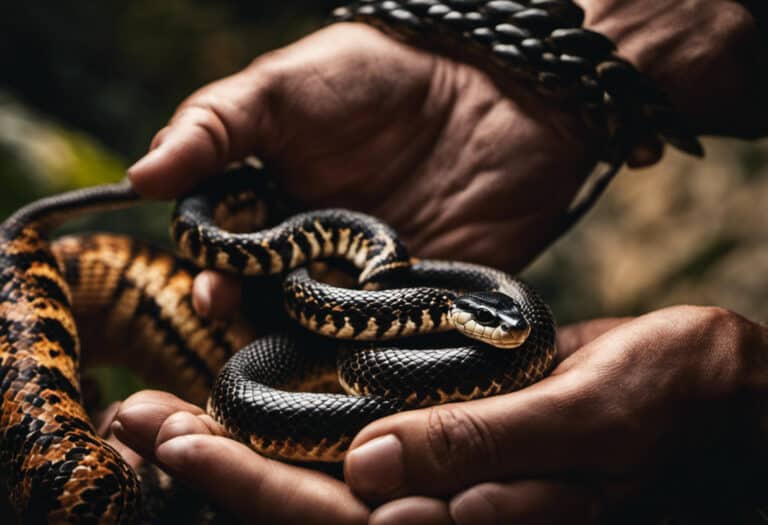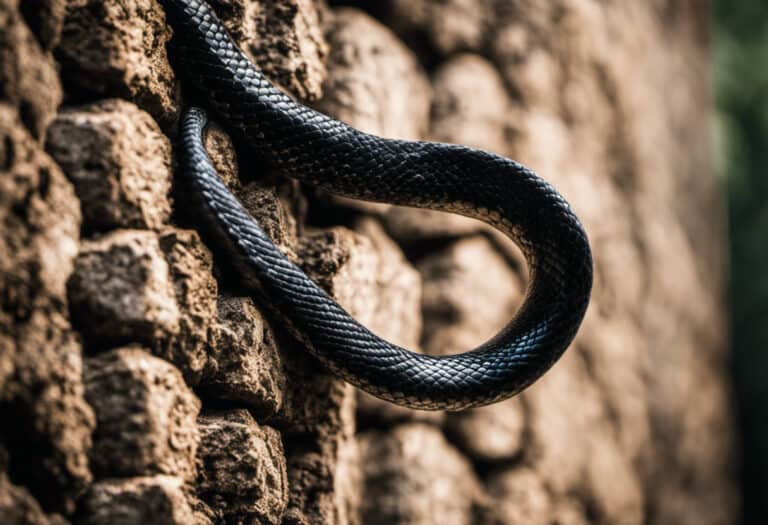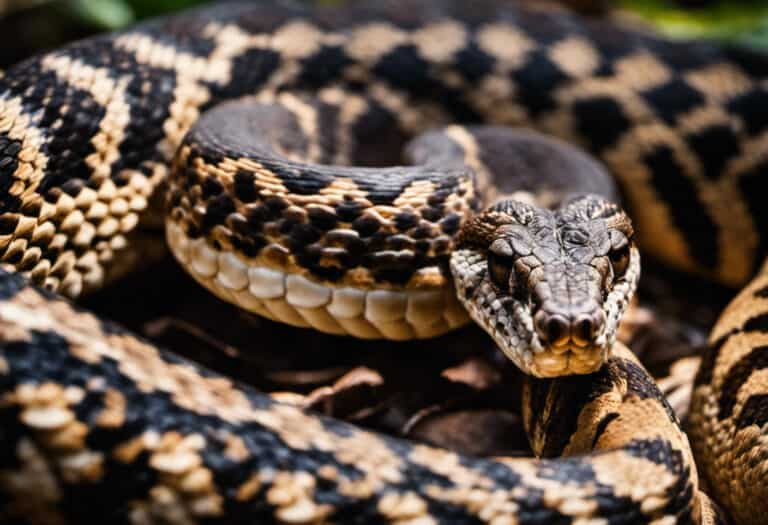Do Bull Snakes Have Venom?
Are you curious about whether bull snakes have venom? Look no further, because this article has all the answers you need.
If you love reptiles or have encountered a bull snake before, it’s important for your safety to understand their venomous capabilities. We will delve into the fascinating world of bull snakes and explore whether or not they possess venom.
By the end, you’ll have a clear understanding of how bull snakes defend themselves and whether their bite should be a concern.
Get ready to uncover the truth about bull snakes and their venomous nature.
Key Takeaways
- Bull snakes are non-venomous reptiles and do not possess venom glands or fangs.
- Bull snakes rely on their powerful constricting abilities to subdue prey, using constriction to cut off circulation and cause suffocation.
- Bull snake bites are non-venomous and generally harmless, typically resulting in minor injuries such as puncture wounds.
- Bull snakes play a crucial role in controlling rodent populations and have a diet consisting mainly of small mammals.
The Anatomy of Bull Snakes
You might be surprised to learn that bull snakes have unique anatomical features that contribute to their ability to capture and consume their prey.
One of the key characteristics that aids in their hunting is their incredible jaw flexibility. Bull snakes have a specialized hinge joint in their lower jaw that allows them to stretch their mouth wide open, enabling them to swallow prey much larger than their own head.
Additionally, they possess sharp, recurved teeth that help them hold onto their prey securely.
Another notable feature is their muscular body, which allows them to constrict their prey. This behavior is especially beneficial when hunting small mammals or birds.
Bull snakes are also known to exhibit a feeding response, which means they can be triggered to strike and constrict even when not hungry.
Overall, these anatomical adaptations make bull snakes highly efficient predators in their diet.
Understanding Snake Venom and Its Effects
Snake venom can have a variety of effects on the human body. It’s important to understand the mechanisms of snake venom and how it impacts our physiology. Here are some key points to consider:
-
Composition of Snake Venom:
-
Snake venom is a complex mixture of proteins, enzymes, peptides, and other bioactive molecules.
-
Different snake species have different venom compositions, making each venom unique.
-
Snake Venom Effects:
-
Venom can cause local effects such as pain, swelling, and tissue damage at the site of the bite.
-
Systemic effects include disruption of blood clotting, cardiovascular instability, and neurotoxicity.
-
Some venoms can also cause renal failure, respiratory distress, and even death if left untreated.
Understanding snake venom and its effects is crucial for the development of effective antivenoms and the proper management of snakebite envenomation.
Bull Snakes: Venomous or Non-Venomous
Bull snakes, also known as gopher snakes, are non-venomous reptiles that belong to the Colubridae family. They’ve no venom glands or fangs, making them harmless to humans.
Instead, bull snakes rely on their powerful constricting abilities to subdue their prey.
Bull Snake Venom
If bitten, be aware that bull snakes don’t possess venom and aren’t dangerous to humans. Bull snake venom composition is an interesting topic to explore. While bull snakes lack venom, it’s crucial to understand the composition of snake venom in general. Here are two subtopics to delve into:
-
Understanding snake venom composition:
-
Snake venom is a complex mixture of proteins and enzymes.
-
Different snake species have different venom compositions, tailored to their specific prey.
-
Bull snake venom and prey immobilization:
-
Bull snakes rely on constriction rather than venom to subdue their prey.
-
Constriction involves wrapping their bodies around the prey, cutting off circulation and causing suffocation.
Venomous or Harmless
You may be wondering whether or not bull snakes are venomous or harmless to humans. Well, I’m here to provide you with some detailed, scientific information on the matter.
Bull snakes are actually harmless to humans, as they aren’t venomous. Their behavior is typically non-aggressive, and they’ll only bite if they feel threatened or cornered. However, their bites aren’t dangerous and rarely result in any harm.
Bull snakes are constrictors, which means they subdue their prey by coiling their bodies around them and squeezing. Their diet consists mainly of small mammals, such as mice, rats, rabbits, and even birds.
Snake Venom Effects?
Rest assured, the effects of snake venom aren’t a concern when it comes to bull snakes. Unlike venomous snakes, bull snakes lack the ability to produce venom and inject it into their prey or potential threats. This is good news for those who encounter these harmless reptiles in the wild.
However, it’s important to note that while bull snakes aren’t venomous, they can still bite if they feel threatened. If you happen to be bitten by a bull snake, you may experience mild symptoms such as pain, swelling, and redness at the site of the bite. It’s recommended to clean the wound thoroughly and seek medical attention if necessary.
Venomous Snakes: A Closer Look at Their Fangs
When examining venomous snakes, it’s essential to take a closer look at their fangs. These specialized structures serve a crucial function in delivering venom to their prey or potential threats.
Venomous snake fangs come in various shapes and sizes, depending on the species, but all share the common trait of being hollow and connected to venom glands.
Snake Fangs and Function
Bull snakes have specialized fangs that enable them to grasp and immobilize their prey. These fangs are located in the upper jaw and are curved backward. They have a hollow channel that allows venom to flow through when the snake strikes.
The fangs are connected to venom glands located towards the rear of the head. The venom delivery mechanism of bull snakes is similar to other venomous snakes. When the snake strikes, its fangs penetrate the prey’s skin, allowing venom to be injected into the wound. The venom contains enzymes that break down the prey’s tissues and help in digestion.
However, it’s important to note that bull snakes aren’t considered dangerous to humans as their venom isn’t potent enough to cause significant harm.
Types of Venom Glands
Now let’s delve into the fascinating realm of venom glands, where the true power of venomous snakes lies.
Venom glands are specialized structures found in venomous snake species that produce and store venom. These glands are located just behind the snake’s eyes, connected to their fangs through a duct system.
The venom itself is a complex mixture of proteins, enzymes, and other components. The composition of snake venom can vary greatly between different species, and even within the same species.
Some venomous snakes produce neurotoxic venom that acts on the nervous system, while others have hemotoxic venom that affects the blood and tissues.
Understanding the types of venom glands and their composition is crucial in appreciating the diverse and potent arsenal that venomous snakes possess.
Debunking Myths: Bull Snakes and Venom
Contrary to popular belief, you may be surprised to learn that bull snakes aren’t venomous or dangerous. Despite their intimidating appearance and reputation, bull snakes are harmless to humans. Here are some key facts to debunk the myths surrounding bull snakes:
-
Bull snake bites:
-
Bull snakes have teeth, like all snakes, but their bite isn’t venomous.
-
If provoked or threatened, bull snakes may bite as a defense mechanism, but their bites are non-venomous and generally harmless.
-
Bull snake diet:
-
Bull snakes are constrictors, meaning they catch their prey and then squeeze it to death.
-
Their diet consists mainly of small mammals, such as mice, rats, and rabbits.
Safety Tips: Interacting With Bull Snakes
If you encounter a bull snake, remember to give it space and avoid any sudden movements. Bull snakes are known for their unique behavior and can be found in various habitats across North America.
These non-venomous reptiles are often mistaken for rattlesnakes due to their similar appearance and defensive behavior. However, bull snakes are harmless and pose no threat to humans.
When handling a bull snake, it’s important to use proper techniques to ensure both your safety and the snake’s well-being. Approach the snake calmly and confidently, supporting its body to prevent injury. Avoid grasping the head or tail, as this can cause stress and potentially harm the snake.
Frequently Asked Questions
What Are the Physical Characteristics of Bull Snakes?
Bull snakes have distinct physical characteristics. They can grow up to 6 feet long, with a slender body and patterned scales. They are found in a variety of habitats and display unique behaviors like bluffing and hissing.
How Does Snake Venom Work and What Are Its Effects on Humans?
Snake venom is a powerful substance used by snakes to immobilize and kill their prey. It affects prey animals in various ways, depending on the species. Humans extract snake venom for medical purposes to develop antivenom and study its effects on the body.
Can Bull Snakes Bite and Inject Venom?
Bull snakes can bite without injecting venom, making them less dangerous than venomous snakes. Additionally, they are immune to their own venom, which further reduces the risk of harm to humans.
Are There Any Venomous Snakes That Closely Resemble Bull Snakes?
While some venomous snake species closely resemble bull snakes, it is important to note that bull snakes themselves do not possess venom. These mimics, such as the Eastern Hognose snake, employ visual deception as a defense mechanism against potential predators.
Are There Any Common Misconceptions About Bull Snakes and Venom?
Common misconceptions about bull snakes and venom include the belief that they are venomous. However, bull snakes are non-venomous and belong to a group of snakes known as constrictors. Understanding the differences between venomous and non-venomous snakes is crucial.
Conclusion
In conclusion, after a thorough examination of bull snakes and their venomous capabilities, one thing is clear – bull snakes aren’t to be taken lightly! These seemingly harmless creatures possess a deadly secret, as their venomous bite can cause catastrophic consequences.
So, the next time you come across a bull snake, remember to proceed with caution and treat them with the respect they deserve. Don’t underestimate these fascinating reptiles, for their venomous nature is sure to leave you in awe.






